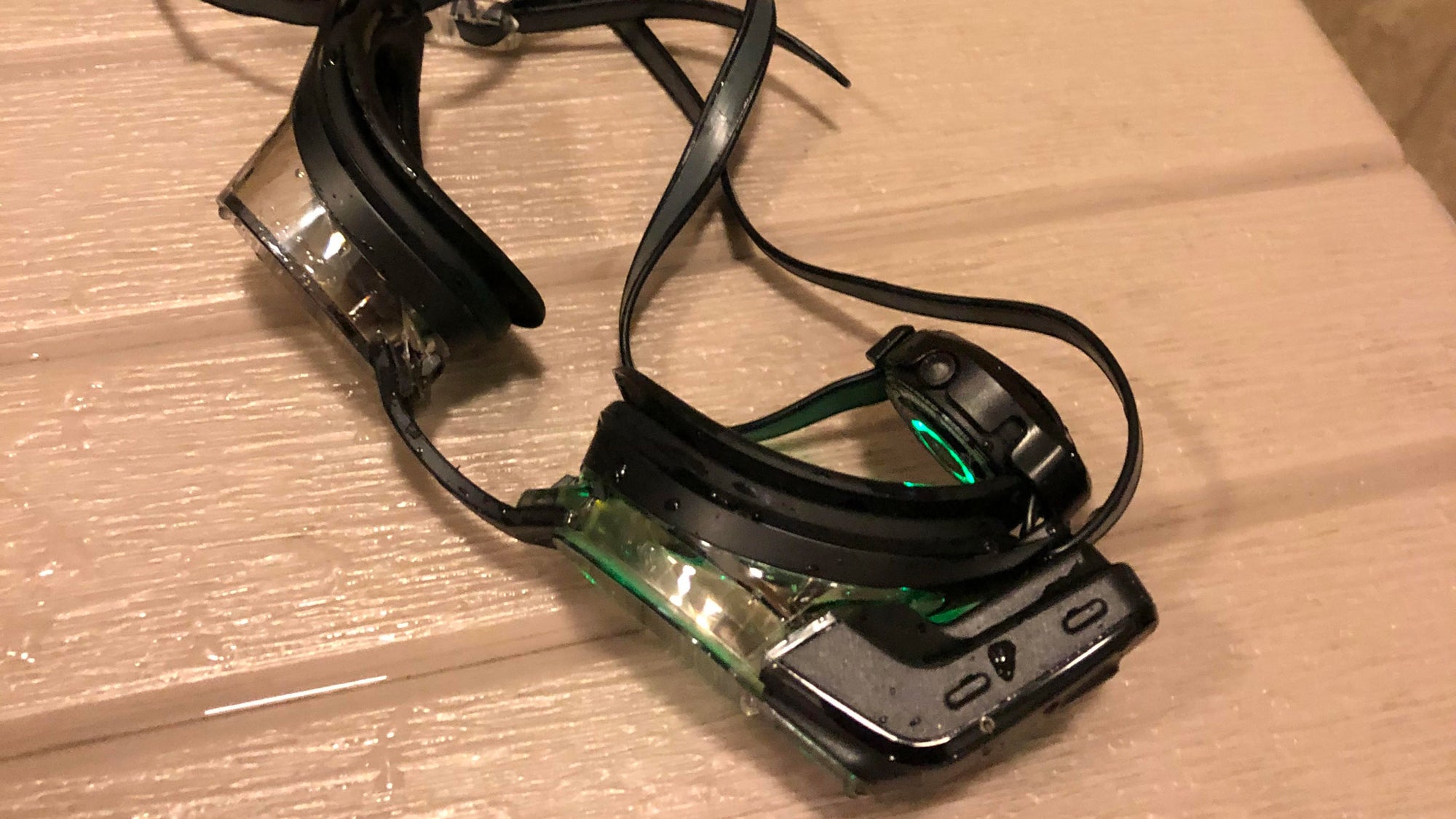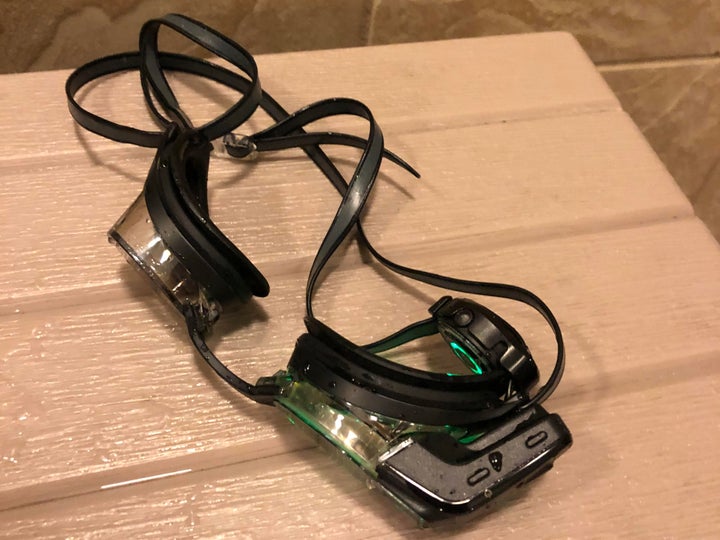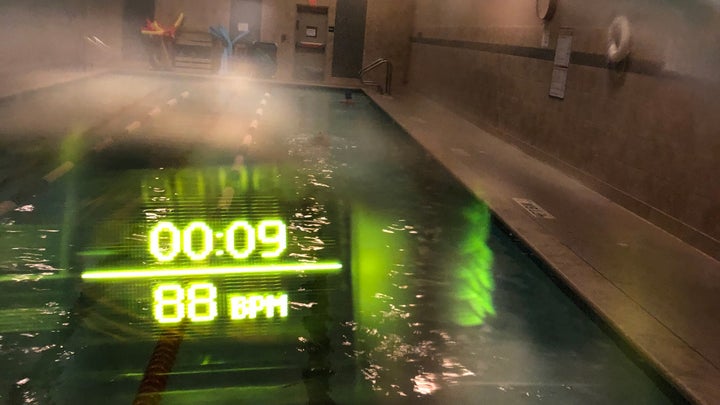FORM Goggles + Polar: The First Useful Heart Rate Visual for Swimmers?

FORM goggles and Polar have teamed up to provide accurate heart rate data viewed through the goggles’ heads-up-display while swimming. This may be the first time heart-rate numbers have been measured and displayed in a useful and precise way for swimmers, and it’s a fundamental step forward for anyone interested in heart-rate training in the pool.
FORM Goggles FTW
A few months ago I wrote about the new FORM swim goggles. They revolutionize how data is viewed and recorded during swimming using a heads up display inside the goggles. Compared to a watch, the goggles provide more accurate tracking and the ability to see metrics without breaking stroke. While it’s not a perfect system yet for triathletes or open-water swimmers (most of the metrics rely on pool swimming with set lap lengths), there’s a lot to love. To save space, we won’t get too deep into the basic FORM goggle functions, so please check out the review if you want to learn more.
A few weeks before that, Sara McLarty reviewed the Instabeat goggles, a slightly similar—although simpler—concept that collects heart-rate data via a device on the goggle’s strap and changes the color of a light beamed next to the swimmer’s eye. Unlike the FORM setup, Instabeat doesn’t display any precise numerical data.
FORM Goggles 2.0
Recently, an update was released that makes the FORM goggles even more revolutionary, allowing them to connect to the Polar OH1 or OH1+ heart rate monitors. This allows the goggles to add a valuable metric and display it in real time through the in-goggle display.

The Polar OH1 is an optical heart-rate monitor about the size of a quarter that measures heart rate through the temple. Compared to other heart-rate monitors that are worn on the wrist or around the chest, the OH1 is far less obtrusive. It clips to a goggle strap and rests against the temple. Once I situated the OH1 pod and paired it with the goggles I quickly forgot it was there.
FORM Goggles, Tested
Pairing was seamless. The two devices linked up quickly and ran a test to show my heart rate in real time on the lense of the goggles. Through the FORM app I reconfigured my display metrics so that heart rate was shown on the primary screen. For testing, I made sure a heart rate metric was shown on each of the three workout dashboards. During an interval the goggles displayed interval time on the top line, and current heart rate on the bottom. On the Turn Dashboard was lap split and HR Zone, while the Rest Dashboard showed interval time and average heart rate.

It worked flawlessly. The two lines of display inside the goggles showed me time and heart rate data, which is updated in real time. After 30 years of competitive swimming, this was literally the first workout where I could adjust my pace and stroke in real time to see how it affected my efficiency in the water.
FORM Goggles Lets HR Get Wet
Heart-rate based training has been popular since Polar released the first consumer wireless EKG in the early 1980’s. Today it is hard to find a book on endurance training that doesn’t include heart rate as a key metric for training intensity, yet for swimmers this metric has been nearly impossible to use effectively. The problem is in accuracy and usefulness. For years swimmers have taken their pulse manually, holding two fingers to their neck while watching the clock for 10 seconds. Previous attempts to solve the problem include chest straps that log the data for later viewing, or wrist watches that show optical heart rate while swimming. Each solution has its own problems, and none of them allow heart rate to be viewed while swimming naturally.
Not Quite Perfect

After using the product for a week, there are a couple of slight drawbacks: First, the OH1 requires separate charging and is a little tricky to get out of the goggle clip. I got used to removal, but keeping track of another proprietary charger and ensuring both the goggles and the HR monitor were charged was not ideal. Second, the sensor setup says not to place the OH1 over hair. I found there wasn’t a lot of space between the edge of the goggle and my hairline, but even when things got “hairy,” the sensor appeared to be accurate.
At $200 for the goggles and $80 for the heart-rate sensor, this is an expensive setup for something that swimmers have done without since… well, since forever. But that’s also why it might be worth it. If you practice HR based training, and want to extend that into the pool, there is no better option.
A Step Forward
What FORM and Polar have done takes heart rate to the next level, delivering high accuracy, comfort, and the ability to use the data while training. Unlike previous sensors, the OH1 is easily forgotten, accurate, and capable of connecting directly to the goggles. Triathletes should also take note that this extends the open-water capabilities of the otherwise pool-locked FORM goggles, as the heart-rate function works fine outside of the pool (stroke rate and time still work in open-water, but none of the valuable pacing/distance metrics are available, yet). While it’s still not perfect, this partnership brings forward a revolution in swim training and could very well be the future of swim training.